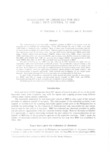The main purpose of the insecticide evaluation activities at IRRI is not routine work for screening but to establish the methodology. From 1960 through the end of 1981, more than 1,000 kinds of chemicals were evaluated. Most of them were conventional insecticides and few are insectistatics including Chilo pheromones. Thirteen important pests are targeted for evaluation. Nine species are used in laboratory tests: rice bug (RB), brown planthopper (BPH), green leafhopper (GLH), whitebacked planthopper (WBPH), striped stem borer (SSB), yellow stem borer (YSB), leaf folder (LF), rice caseworm (RCW), and rice armyworm (RAW), whereas 8 in field tests: RB, BPH, GLH, WBPH, SSB, YSB, LF, and rice whorl maggot (RWM). Rearing methods of BPH, GLH, WBPH, SSB, YSB, LF, RCW, RB, and RAW have been developed at IRRI.
The rate of 0.75 kg a.i. in 1,0001 (for lab. test) and in 300 l water/ha (for field test) for insecticides other than synthesized pyrethroids is used. For pyrethroids a rate of 0.05 kg a.i./ha is used. For broadcast, root-zone, and soil incorporation treatments, rates of 0.75 or 1.0 kg a.i./ha are used. In the laboratory, chemicals are evaluated mostly in contact toxicity tests, foliar sprays on plants, broadcast, root-zone application of gelatine capsule granules and liquid solution, and
soil incorporation of granules and liquid. Other methods such as dipping, etc. are tested experimentally. Insecticides showing 80% or more mortality are recommended for field tests. In open fields, chemicals are evaluated by either natural infestation (usually in stem borers, LF, RWM, and RB) or caging inscctary-reared insects (usually in BPH, GLH, and WBPH).Insecticides showing 40% or more mortality are considered to be promising.
Methodology for the evaluation of insectistatics has not been established.

